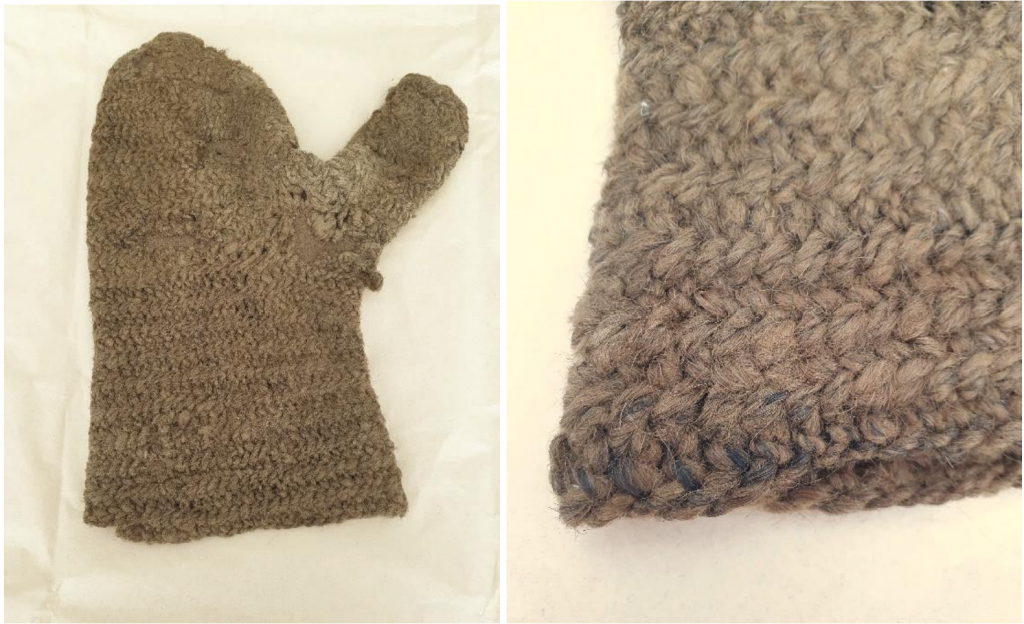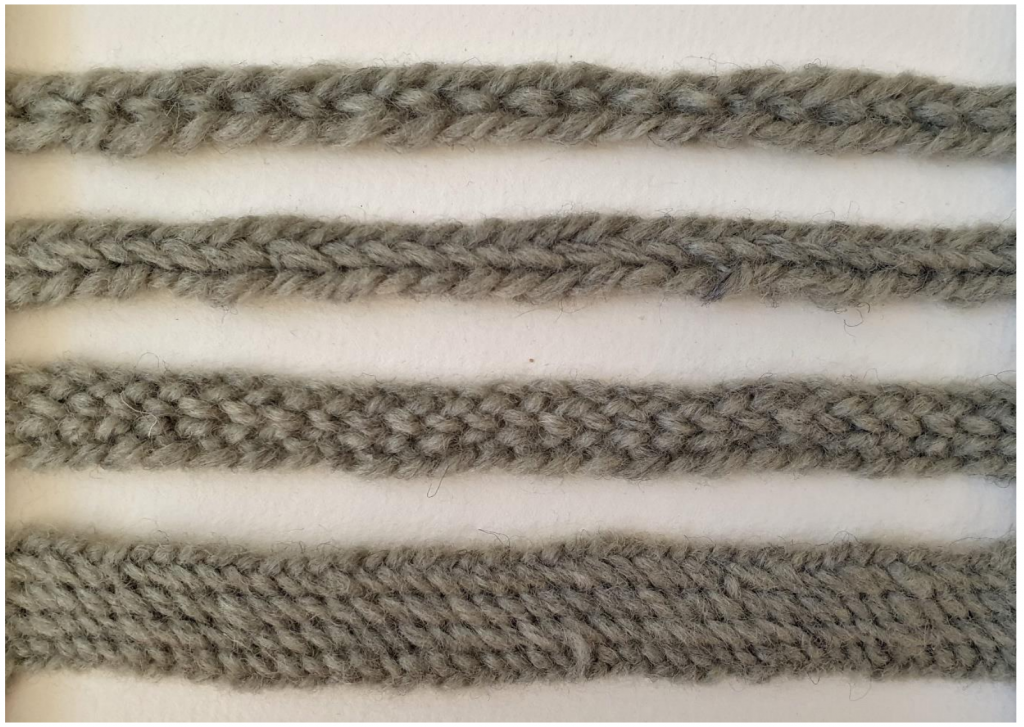For our experiential research, we have decided to focus on the relationship between medieval textile work and disability. Specifically, we will be exploring this topic through Scandinavian nålbinding. Predating knitting and crocheting, this type of medieval needlework produced essential fabrics for the Scandinavian medieval period. With the use of only needle and thread, Nålbinding offered a variety of comforts and employment.

This mitten shows the level of craftsmenship and size of a common nålbinding stitch used in fabric making.
Photo taken by Ingela Andersson Lindberg.
Disability, in its many forms, can be traced all throughout history, through all classes, races, genders, and all other social locations; there is no society or era of history that is not affected by disability. In most, if not all of the world’s civilizations, certain groups of people are always disproportionately affected by any type of hardship. In Viking era Scandinavia, one of these groups was certainly the working class, since one’s physical and mental capacity for labour was so integral to survival. Since nålbinding requires tedious craftsmanship and was common among the working class, particularly women, a physical assessment of this craft is essential for understanding their struggles and daily lives.
All of the members of this group have some sort of physical and/or mental disability that affects our day to day lives. Since disabilities have been around as long as humans have, we can use our modern bodies to attempt to understand past experiences. By combining the experiential component of our project with literary research, we can reach a more complex understanding of how disability may have affected working class women of Viking Age Scandinavia.
Research Questions
- How may disability and textile work have influenced each other in the Medieval Viking era?
- How are different disabilities affected by nålbinding?
- Were any accommodations used for disabled textile workers? If so, what? Were they self-made, or widely available?
Methods and Materials
We will visit a fibre arts store in town (Knotty By Nature) to see if they have any needles similar to what would have been used in the Viking age. Luckily, the needles have a very simple design, and can be easily substituted without altering the results of our experiment. We are not sure what exactly we will use yet, but there is a variety of needles available on amazon, and there is also evidence online of people having shaved down popsicle sticks to use as a needle. If none of the above options work, a large darning needle will likely do a similar job, but may be less ergonomically efficient, altering our results. One of the group members will be attempting to make a nålbinding needle from deer bone, if this is successful it will be used for the project.
As for yarn, several of our group members have a wool allergy, so we will not be using merino wool as Scandinavian nålbinders may have. We will instead be using acrylic yarn. This should not be a huge variable in our results, as the bodily mechanics will have the most influence on our results.
In terms of methods that will be used during the experiment, we will attempt to measure how each of our disabilities are affected by nålbinding for certain periods of time. To do this, we will measure our pain, fatigue and focus on a scale of one to ten at given intervals. It is hard to say how long these intervals will be right now, as we have not yet tried nålbinding and don’t know what a realistic or healthy length of time would be. We will rate our pain before, at each of the established intervals, and at a fixed time after we have finished for the day. We will do this multiple times. Though we are using our own bodies and we have all consented to this experiment, we will not push ourselves for the sake of results. Because of this, time intervals may vary by person.
An arrangement of four seperate nålbinding stitch patterns are displayed, showing a small sample of the several techniques used in this craft.
Photo taken by Ingela Andersson Lindberg.

Annotated Bibliography
Andersson Lindberg, I. (2023). Nålbinding connections: Making, mapping and describing connections. Formakademisk, 16(4). doi:10.7577/formakademisk.5419
The author of this article creates and analyses approximately 150 different swatches in order to examine the ways in which the different stitches change the construction of the fabric. The most beneficial aspect of this source is the in depth manner that the author constructs their research through significant imagery and easy to read tables. Similar to another source we are using, this will be useful in learning about the different patterns and techniques that we will be using.
McNabb, C. H. (2020). Medieval Disability Sourcebook Western Europe. Brooklyn, NY: punctum books. https://doi.org/10.2307/j.ctv11hptcd
This source book draws on medieval accounts of both physical and mental disability, medical practices, and legal proceedings in relation to disabilities. This text will give significant insight into the medieval perspective on how disabilities affect daily lives and how the people of the time may have looked on those who lived with them. It includes biblical texts pertaining to miraculous healing which may lend understanding from a religious and cultural point of view.
Metzler, I. (2011). Disability in the Middle Ages: Impairment at the Intersection of Historical Inquiry and Disability Studies. History compass, 9(1), 45-60. doi:10.1111/j.1478-0542.2010.00746.x
The observation of disabilities within the medieval world can be found throughout archaeological evidence. However, its impacts on medieval society are scarcely discussed throughout academic literature. Irina Metzler attempts to acknowledge and expand this unidentified portion of research. They focus on the foundations of medieval disability and its definitions, along with further research developed within this area of medieval societal structure. By emphasising the importance of present disabilities within human history, this paper outlines the need for progress within historical and archaeological academia.
Pearman, T. V. (2010). Women and disability in medieval literature (1st ed.). New York: Palgrave Macmillan. https://ebookcentral.proquest.com/lib/uvic/detail.action?docID=678814
Textile work has been gendered in many historical societies as a female occupation or hobby. Because of this, understanding the social location and point of view of disabled women in medieval literature may help us deepen our understanding of the context in which textile work was conducted. Like, were disabled women seen as important enough to even warrant specific accommodations?
Pepper, H. H., & Kania, K. (2019). Ancient Textiles Modern Science II. Oxford: Oxbow Books. https://doi-org.ezproxy.library.uvic.ca/10.2307/j.ctv13pk8gq
Nålbinding is a historically vast practice, having been utilised by many different groups of people in different geographical locations. Because of this, the language, notation, and methodology has not been standardised until relatively recently. This chapter outlines the developing and changing standardisation of language and notation, which will be very helpful in consulting different patterns and scholarly works during our research.